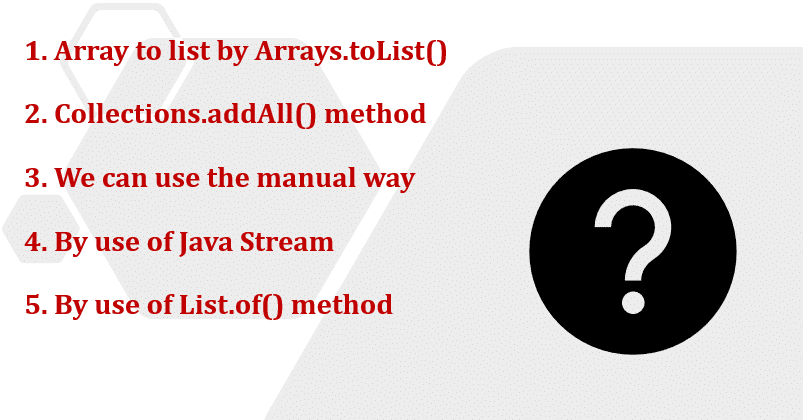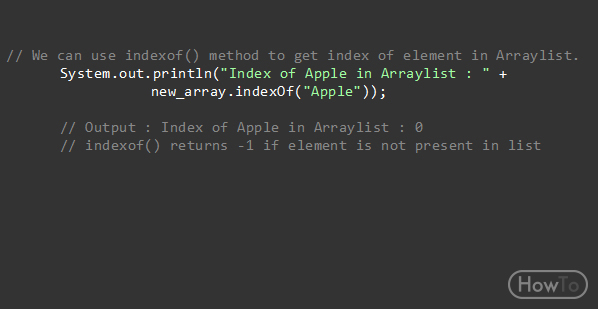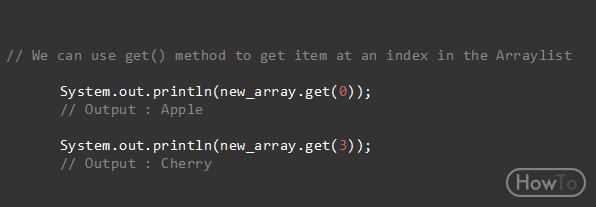
The List object returned by the Arrays.asList() method is a fixed-size list, which means that we cannot add or remove elements from it.

This method takes an array as an argument and returns a List object. The Arrays.asList() method is a built-in method in Java that converts an array into a List.
JAVA ARRAY TO LIST HOW TO
How to Initialize a List Using the Arrays.asList() Method When we run this program, the output will be: Finally, we print the contents of the list using the () method. We then use the add() method to add three strings ("apple", "banana", and "cherry") to the end of the list. In this example, we first create a new ArrayList called myList. add elements to the list using the add() method

Here is an example of how to use the add() method to initialize a Java list: import The add() method can be used to add elements to the end of a list, which makes it a convenient way to initialize a list with some initial values. Lists in Java are ordered collections that can contain duplicates. When it comes to adding elements to a Java List, the add() method is particularly useful. The add() method takes a single argument, which is the element that needs to be added to the collection. This method is available for several types of collections in Java, including List, Set, and Map. The add() method is a commonly used method in Java that is used to add elements to a collection or list. How to Initialize a List Using the add() Method We then pass this List object to the ArrayList constructor to create a new ArrayList with the same elements as the original array. In this example, we create an array of integers and then pass it to the Arrays.asList() method to create a List object. Here's an example of how to create an ArrayList and initialize it with values using the constructor that takes a Collection: import ĪrrayList list = new ArrayList(Arrays.asList(array)) The elements in the collection are added to the new ArrayList in the order they appear in the collection. We can pass any collection object that implements the Collection interface to this constructor, such as another ArrayList or a LinkedList. To initialize a List with values, we can use the constructor that takes a Collection as an argument. Where capacity is the initial capacity of the list. If the list grows beyond that capacity, the ArrayList class automatically increases the capacity by creating a new array with a larger size and copying the elements from the old array to the new array.Īlternatively, we can create an ArrayList object with an initial capacity using the constructor with a single integer argument: ArrayList list = new ArrayList(capacity) The constructor with no arguments creates an empty list with an initial capacity of 10 elements. The syntax for creating an ArrayList object with no initial capacity is: ArrayList list = new ArrayList() The ArrayList class provides several constructors for creating an instance of the class. In Java, the ArrayList class is a dynamic array implementation of the List interface, allowing elements to be added and removed from the list as needed.

How to Initialize a List Using the ArrayList Constructor Let's take a deep look into these methods.

In Java, there are different ways to initialize a list: Whether you are a beginner or an experienced Java developer, this guide will help you understand the best practices for initializing a Java list and improving the performance of your application. In this article, we will explore the different methods to initialize a Java list and provide examples to illustrate their usage. There are various ways to initialize a list in Java, and the choice depends on the specific requirements of the project. Initializing a list in Java is a crucial step in the development process as it defines the initial state of the list and prepares it for further operations. One of the essential data structures in Java is a list, which allows developers to store and manipulate a collection of elements. Java is a popular programming language widely used for developing robust and scalable applications.


 0 kommentar(er)
0 kommentar(er)
